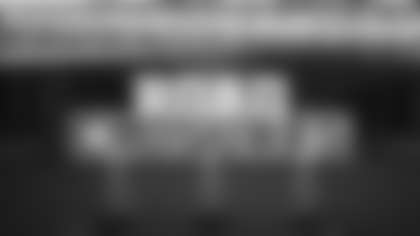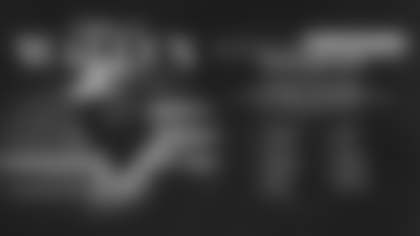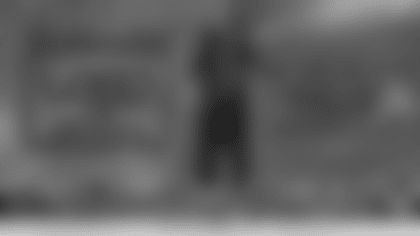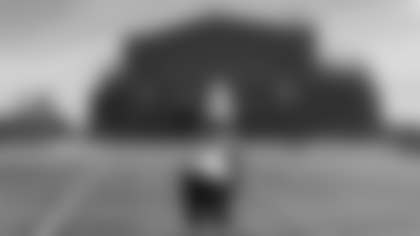Colts Defensive End Howard Still Relatively Inexperienced
at New Position
INDIANAPOLIS – Marcus Howard doesn't possess an overwhelming knowledge when it comes to his new teammates.
He knows Dwight Freeney is very good. And he knows Robert Mathis is, too.
Howard, a defensive end from the University of Georgia who the Colts recently made their fourth selection in the 2008 NFL Draft, said he also knows the members of the above-mentioned pass-rushing tandem aren't considered large by NFL standards.
And that's one thing that Howard said has him excited about his new situation.
He's not big by NFL standards, either.
But he is confident that – like Freeney and Mathis, who have keyed the Colts' pass rush for the past four seasons – he can play in the NFL, anyway.
"I know they play with speed and they're not tall guys," Howard said during a recent interview for this story, the fourth of a nine-part series on the Colts' 2008 draft class that will run on Colts.com in the coming days.
"I think I can fit in with them. I just can't wait to play with those two guys. I can't wait to watch them and try to learn as much as I can from those two."
Colts President Bill Polian, shortly after making Howard the 26th selection of the fifth round – the 161st player selected overall – stressed that Howard was not yet at the level of Mathis, who has registered 38.5 sacks over the last four seasons.
Still, Polian said there is a comparison to be made between Howard and Mathis, who at 6-feet-2, 245 pounds utilizes uncommon speed to be a disruptive defensive force.
"He is not Robert Mathis and we don't want to make him out to be Robert Mathis, but he's like Robert Mathis in style," Polian said, with Colts Head Coach Tony Dungy adding, "He's just really a fast, fast guy who has some power coming off the corner.
"He's going to be an interesting guy to work with."
Toward the end of this past season, with Freeney out the last seven games with a foot injury and Mathis hampered with a knee injury in the final month, the Colts' pass rush struggled at times, and registered one sack in the last three regular-season games and one playoff game.
Dungy and Polian each said after the season the team would like to add a pass rusher from the end position, an approach Polian said led to the selection of Howard.
"We think he gives us the opunity to have a third rusher who if anything happens to the other two (Mathis and Dwight Freeney) we have the ability to fall back on him and still rush the quarterback at the end of the season when it counts," Polian said.
How fast is Howard? Consider:
Mathis and Freeney are two of the fastest players at their position in the NFL, and their speed has helped make the Colts one of the league's fastest defenses. They each run the 40-yard dash in about 4.56-4.57 seconds, Polian said shortly after the draft.
"He's 4.47," Polian said of Howard, adding, ". . . so he's fast. You can see it on tape. There's no hiding it."
Said Howard, "I'm a lot lighter and faster than the offensive tackle most of the time. They get tired before me, and that's when I really try to take advantage of my speed as the game wears on."
Howard during this past weekend's rookie minicamp that he very much agreed with Polian – that any comparisons to Mathis are premature. "I haven't done anything," Howard said. "He's a double-digit sack guy.
"I'm looking forward to meeting them and learning from them," he added of Freeney and Mathis.
Howard's NFL learning process began over the weekend, when he worked with Colts defensive line coach John Teerlinck on a variety of pass-rushing fundamentals, including "trying to get my feet set right and trying to play at a faster tempo," he said.
"The defensive line coach (Teerlinck) is really in tune with certain little things, techniques," Howard said. "My defensive end coach in college, Jon Fabris, he's probably the best defensive end coach in the nation. He's put out a lot of great player in the past years. I just learned a lot from him."
And Howard said he still has much to learn, partly because he has had relatively little experience at the position – at least as a starter.
Howard (6-feet-0, 237 pounds) played four seasons for Georgia, but started just one of those seasons, beginning his career as an outside linebacker and switching to defensive end as a sophomore in 2005. He spent his sophomore and junior seasons playing behind Charles Johnson and Quentin Moses, each of whom was selected in the third round of the 2007 Draft – Johnson by the Carolina Panthers and Moses by the Oakland Raiders.
As a senior, he got his opportunity, finishing the season with 10.5 sacks. He had 12 sacks in four seasons and as a senior, he also registered 42 quarterback pressures, with 12 tackles for losses and three forced fumbles.
"It was my first year starting," Howard said. "I feel like I'm really now just learning the position and playing fast. I knew I was going to have a big year, because I had pretty much done well in practices. I was just behind two NFL guys.
"I felt like going into my third year, when I got switched to defensive end, I knew I could rush the passer. I knew I had been behind a couple of guys who were in the NFL, so I had to keep my mind focused and never give up."
As big as Howard played in the regular season, he got bigger later. He was named the Most Valuable Defensive Player of Georgia's Sugar Bowl victory over Hawaii, then recorded the fastest 40-yard dash time – 4.45 seconds – among defensive ends at the NFL Scouting Combine at the RCA Dome in Indianapolis in February.
He also recorded the second-best vertical jump at the combine among defensive ends when he jumped 34.5 inches.
"I didn't expect to have a big Sugar Bowl game like that," Howard said. "But I knew I was fast, and I figured if I got invited to the combine, I could open a lot of people's eyes. That's what happened. I was waiting on my shot.
"When I got the opportunity, I wanted to make the most of it."














